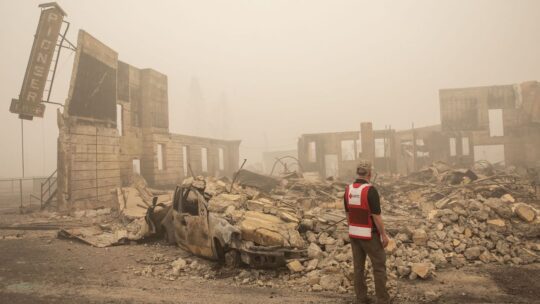
For many, summer brings the promise of trips to the beach, pool parties and camping under the stars. However, the reality for an increasing number of Americans is a season of extreme weather.
Californians are no strangers to annual wildfires; however, the Dixie Fire, raging since mid-July, has become the state’s second-largest wildfire in history. It has torched 783 square miles and at least 1,045 buildings. That includes 550 homes in the northern portion of the Sierra Nevada, according to the California Department of Forestry and Fire Protection. And unfortunately, there's no end in sight, as the Department has contained only 30 percent of the fire.
One organization remains top of mind when it comes to disaster response—the Red Cross. The Red Cross has provided relief to thousands during this time, including securing shelters for the displaced and distributing meals, snacks and relief items, such as prescriptions, glasses and other medical equipment that evacuees may have left behind.
Services also include access to mental health experts to help people process trauma, and distribution of wildfire relief kits. These kits include rakes, gloves, sifters and other essentials to help residents start clean-up efforts.
Essential Workers
These disasters showcase how essential communication is to a crisis, before, during and after. A team of 35 helps keep the Red Cross communication flow going. They cover everything from national media outreach to social media, editorial content and public inquiry, as well as public affairs on a local level.
Jenelle Eli, senior director, media relations at the American Red Cross, said the team deals with crises on a daily basis.
“The American Red Cross responds to disasters every single day of the year—and some 60,000 disasters annually, most of which are home fires—so our teams are always at the ready,” Eli said. “On the communications team, we have staffers on-call 24/7 and have really tight SOPs (standard operating procedures) to ensure we’re getting information out to people in need as quickly as possible.”
Eli said the team adjusts its response depending on the scale of the disaster.
“To help determine our communications strategy, we consider how many people have been affected and how long they may need our help,” she said. “Disasters like the Dixie Fire can be unpredictable because the fire’s boundaries are constantly shifting, and we’ve seen the fire grow from day to day, due to shifting weather conditions. A big part of our job is letting people impacted by disasters know how and where to find help.”
Reaching Those in Need
Eli said that because every disaster is different, the team works to reach people in need where they are and looks for any opportunity to connect with those who may need help.
“We depend on news media, social media, our mobile apps, local community leaders, local organizations, faith-based groups and government officials to share that the Red Cross is there to help people in their time of need.”
The range of communication tactics is wide. Depending on the situation, the Red Cross may post flyers or go door-to-door to reach people. "In the past, we’ve also visited campsites, RV parks and hotels to share information.”
And because the country is vast, diversity, equity and inclusion also play a large role in how the Red Cross communicates. The group focuses on recruiting local volunteers who speak the languages of affected communities. This helps communicators understand the needs of those served.
“It is critical that people affected by disasters understand how to access our services, no matter what language they speak,” she said. “We share information and materials with many of our partners who provide services to non-English-speaking communities. And we provide disaster preparedness and safety information in a variety of languages." These include Spanish, Vietnamese, Creole and Chinese. It used interpreters as needed.
In addition to posting information to a variety of digital and social platforms (Twitter, Facebook, Instagram, TikTok, LinkedIn, YouTube and Vimeo), Red Cross communicators focus on local media relations.
“We work through media outlets to raise awareness about humanitarian needs,” she said. “Our teams are often the first on the ground during a disaster, so we’re able to provide insight, information and visual media (photos and video) that media outlets might not be able to access.”
During a disaster, and particularly during this busy wildfire season, communicators cannot work in a vacuum.
“Working closely with local community leaders, local nonprofits, faith-based groups and government officials is critical to making sure we can reach a larger variety of people who need help,” she said. “Effectively responding to disasters is a team effort. Typically, there’s more work than any one organization can do... The best solution is for groups of all sizes to work together to aid people in need, which helps us avoid duplication of effort and ensure gaps are filled."
For more information about the American Red Cross’s wildfire preparation and response, and to learn how you can help, visit its website.
Nicole Schuman is senior editor for PRNEWS. Follow her @buffalogal
